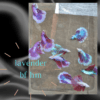Selecting and Breeding Pair of Giant Betta Fish

Breeding giant betta fish is a rewarding endeavour for aquarists, but it requires a certain level of consideration and planning. From selecting the right breeding pair to creating the optimal breeding environment, each step plays a crucial role in the success of the breeding process. In this guide, we will explore the essential factors to consider when choosing a breeding pair of giant betta fish.

1. Age and Characteristics
When selecting a breeding pair of giant betta fish, it is essential to choose individuals that exhibit the desired characteristics you wish to pass on to their offspring. Each fish should ideally be between 5 and 12 months old for optimal breeding. Look for traits such as vibrant colors, robust fins, and overall good health. Additionally, aim for a pair that are close in age and size, with the female being slightly smaller than the male.
2. Source from Reputable Retailers or Breeders
Avoid purchasing betta fish from chain pet stores, as they often carry older bettas that may not be suitable for breeding. These fish may be past their prime breeding age or poorly bred, leading to inferior offspring. Instead, seek out reputable retailers or breeders who specialize in giant betta fish. While giant bettas may be rare, it's worth the effort to find a trusted source to ensure the quality of your breeding pair.
3. Health and Conditioning
Before initiating the breeding process, it is crucial to ensure that both the male and female betta fish are in good health. Giant bettas, with their bulkier physiques, may have poorer stamina compared to their smaller counterparts. To improve their agility and stamina, provide ample space for the male to swim and exercise. Consider using a large tank or bucket to condition the male before introducing the female for breeding.
4. Breeding Environment
Prepare a suitable breeding tank for your betta pair, ideally a 10-gallon aquarium with a divider to separate the male and female until breeding begins. Place the breeding tank in a quiet spot to minimize stress and provide privacy for the breeding pair. Avoid using filters in the breeding tank, especially if your bettas are bubble nesters, as they may disrupt the nesting behaviour. Provide hiding spots for both fish using betta-safe plants or aquarium decor to reduce anxiety and promote successful breeding.
5. Temperature and Water Conditions
Maintain stable water temperatures in the breeding tank, as temperature fluctuations can affect the breeding behaviour of betta fish. Use a water heater to ensure consistent warmth, which is essential for inducing breeding and spawning. Avoid using substrates in the breeding aquarium, as it can interfere with the collection of eggs during spawning.
Opting for a bare-bottom tank makes it easier for the betta pair to retrieve any dropped eggs and reduces the risk of contamination. In conclusion, choosing a breeding pair of giant betta fish requires careful consideration of various factors, including age, health, and breeding environment. By selecting the right pair and providing optimal conditions for breeding, aquarists can enjoy the beauty of raising healthy offspring and contribute to the preservation of this unique species.
REFERENCES:
- Giant Betta Fish Care Guide 101: Look, Size, & More | 2024
- King and Giant Bettas
- Mastering Fish Grooming: A Guide to Enhancing Your Aquatic Pets’ Growth and Form

Facebook | Instagram | Telegram | Youtube | Twitter | Posts |














